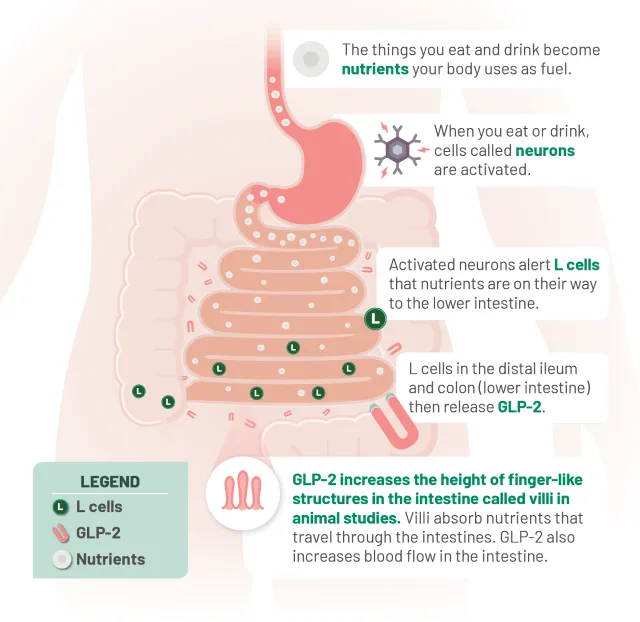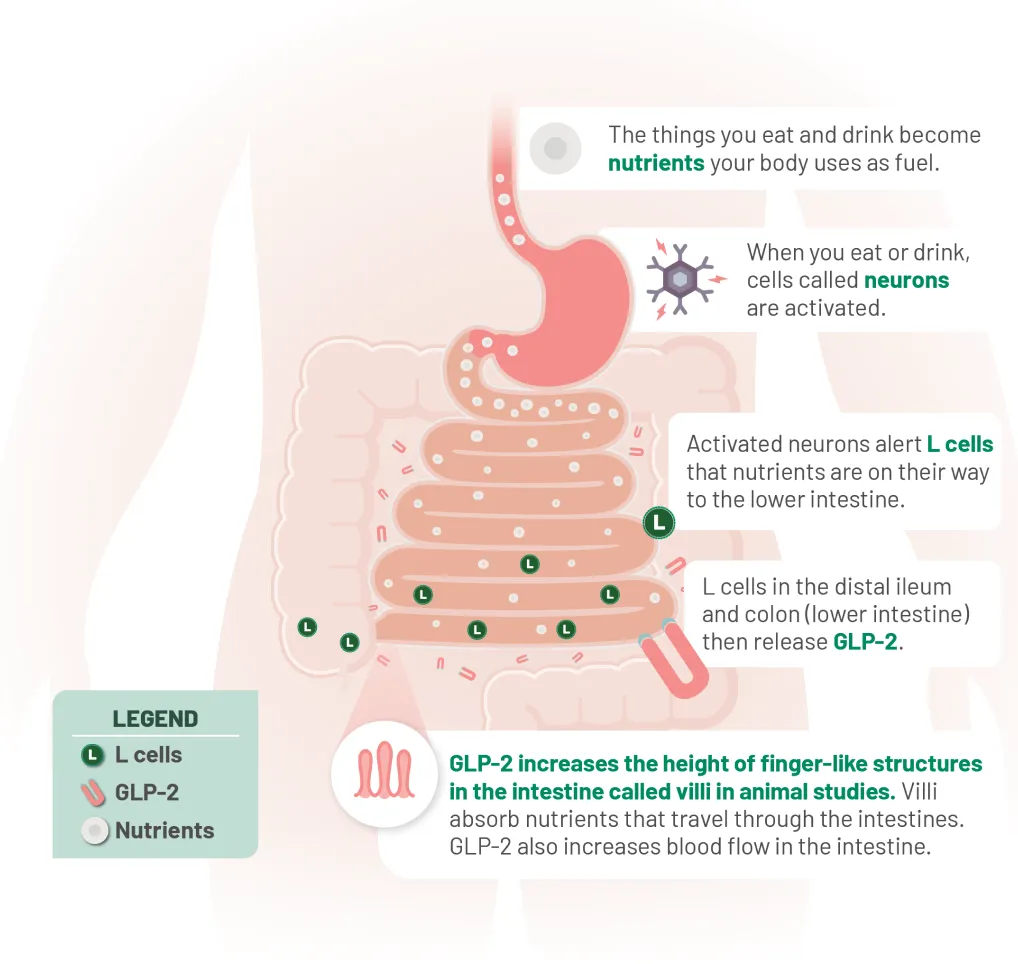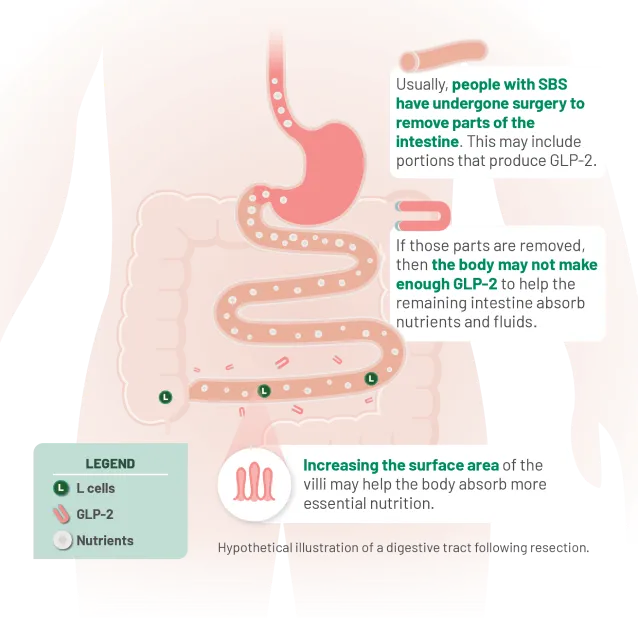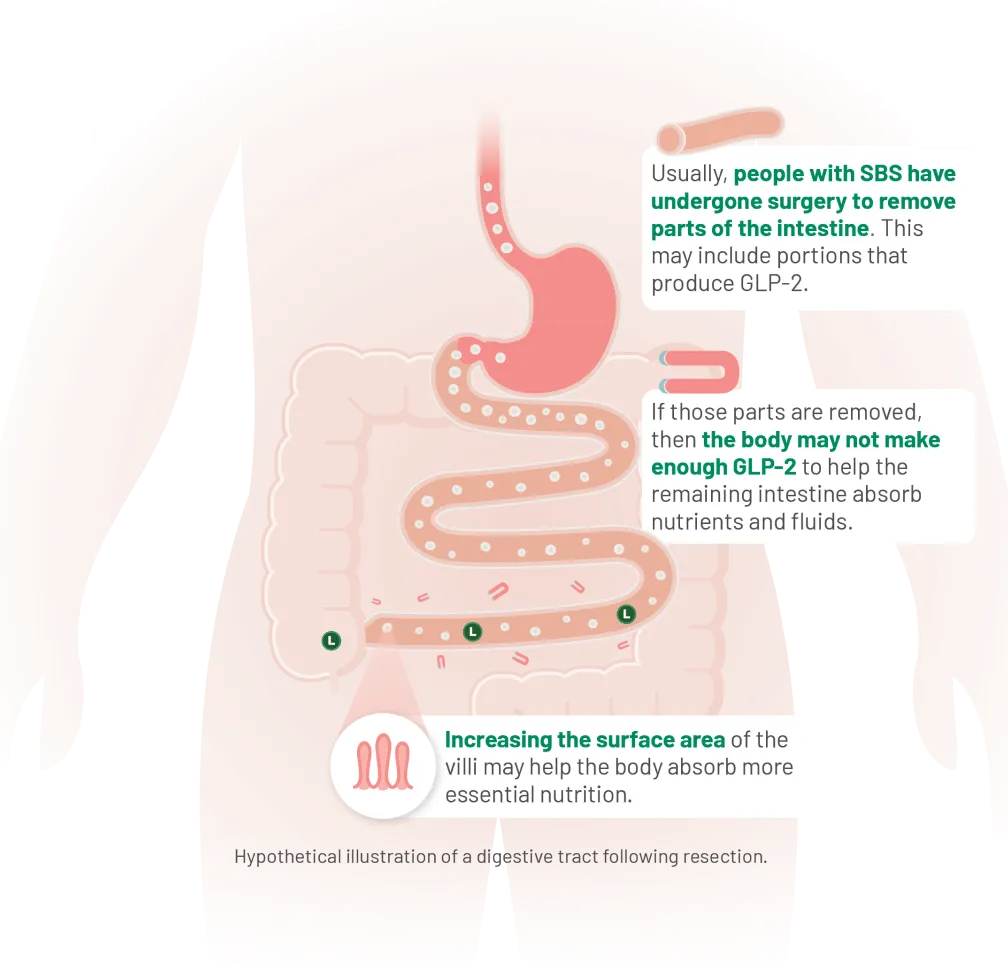Approved for adults in 2012
HOW DOES GATTEX WORK?
KAT
Treating her SBS with GATTEX

For people 1 year of age and older with SHORT BOWEL SYNDROME (SBS) who are dependent on parenteral support (PS).
Understanding the importance of GLP-2
What is GLP-2 and its role in the body?
GLP-2 helps your body absorb essential nutrients and fluids. Many people with SBS have trouble producing enough GLP-2 since parts of their intestines, where GLP-2 is naturally made, have been surgically removed.
Complete intestine


Resected intestine


What is GATTEX?
GATTEX® (teduglutide) for subcutaneous injection is a prescription medicine used in adults and children 1 year of age and older with short bowel syndrome (SBS) who need additional nutrition or fluids from intravenous (IV) feeding (parenteral support). It is not known if GATTEX is safe and effective in children under 1 year of age.
GATTEX works like a natural gut hormone produced by your own body, known as glucagon-like peptide-2 or GLP-2.
In a study of adults, GATTEX was proven to help the remaining intestine absorb more fluid.*
The ability of GATTEX to improve the amount of fluid absorbed by the intestines was studied in 17 adult subjects with SBS. Participants in the study received GATTEX for 21 days. All the participants in this study knew they were taking GATTEX. They each took daily doses of either 0.03, 0.10, or 0.15 mg/kg by subcutaneous injection (0.6 to 3 times the recommended dose). The recommended dose is 0.05 mg/kg/day. The injections were administered under the skin in the stomach area (abdomen). All of the doses studied, except for the 0.03 mg/kg once-daily dose, resulted in enhanced absorption of fluid by the intestines—approximately 750 to 1000 mL per day—and increased the surface area of the intestines.
The ability of GATTEX to improve intestinal absorption in children has not been investigated.
See GATTEX in action
GATTEX works like the GLP-2 the body naturally makes on its own. To understand how it works, let’s begin with a better understanding of short bowel syndrome. Watch now.
Narrator: When living with short bowel syndrome, or SBS, maintaining proper nutrition and hydration can be complicated. Understanding how a healthy bowel works may help explain how nutritional needs change after parts of the intestine are removed, as is often the case for people with SBS. Let's take a look.
After eating, the stomach starts to break up food. Then, as food moves into the small intestine, a majority of the nutrients, such as fats, vitamins, and minerals are absorbed, while the large intestine absorbs mostly water and electrolytes. As the stomach starts to digest food, nerves are stimulated to send signals to the far end of the lower intestine and part of the large intestine that nutrients are on the way.
The signals are sent to L-cells which trigger the release of hormones to aid in digestion. GLP-2, or glucagon-like peptide 2, is one of the hormones released. It plays a key role in helping the intestines absorb nutrients in a variety of ways. GLP-2 increases the height and depth of finger-like structures in the intestine known as villi. Since nutrients are absorbed through the villi, the greater height and depth increases intestinal surface area so more nutrients can be absorbed. Additionally, GLP-2 reduces gastric acid secretions, slows the movement of food, allowing more time for nutrients to be absorbed, and increases intestinal blood flow.
When someone has SBS, parts of the intestine have been surgically removed, and the remaining intestine may not be able to absorb enough nutrients from food or drink. Surgery may also remove portions of the intestines that include the L-cells that produce GLP-2.
Because of the malabsorption associated with SBS, some people are dependent on parenteral support, which ranges from IV hydration to total parenteral nutrition, to get the nutrients they are no longer able to absorb through the remaining intestines.
GATTEX (teduglutide) for subcutaneous injection (under the skin) is a prescription medicine used in adults and children one year of age and older with short bowel syndrome (SBS) who need additional nutrition or fluids from intravenous (IV) feeding (parenteral support). It is not known if GATTEX is safe and effective in children under one year of age.
GATTEX may cause serious side effects including making abnormal cells grow faster, polyps in the colon (large intestine), blockage of the bowel (intestines), swelling (inflammation), or blockage of your gallbladder or pancreas, and fluid overload.
The full Important Safety Information for GATTEX is available at the end of this video.
When GATTEX (teduglutide) is injected into the body, it moves through the bloodstream until it reaches the intestinal cells in the digestive tract. GATTEX is structurally similar to the GLP-2 the body would naturally make on its own. In fact, the only difference from GLP-2 is a single amino acid, which slows the breakdown of GATTEX.
About half of the body's own GLP-2 gets broken down every seven minutes. In adults with SBS, about half of GATTEX is broken down in approximately 1.3 hours. In the intestines, GATTEX was designed to increase the height of the villi, as well as the depth between each villus, to allow for more intestinal absorption, similar to the body's own GLP-2.
Talk with your doctor to learn more about GATTEX or visit GATTEX.com.
Important Safety Information
What is GATTEX?
GATTEX (teduglutide) for subcutaneous injection is a prescription medicine used in adults and children 1 year of age and older with short bowel syndrome (SBS) who need additional nutrition or fluids from intravenous (IV) feeding (parenteral support). It is not known if GATTEX is safe and effective in children under 1 year of age.
What is the most important information I should know about GATTEX?
GATTEX may cause serious side effects, including:
Making abnormal cells grow faster
GATTEX can make abnormal cells that are already in your body grow faster. There is an increased risk that abnormal cells could become cancer. If you get cancer of the bowel (intestines), liver, gallbladder, or pancreas while using GATTEX, your healthcare provider should stop GATTEX. If you get other types of cancers, you and your healthcare provider should discuss the risks and benefits of using GATTEX.
Polyps in the colon (large intestine)
Polyps are growths on the inside of the colon. Your healthcare provider will have your colon checked for polyps within six months before starting GATTEX and have any polyps removed. Children and adolescents will be checked for blood in the stool before they start using GATTEX.
To keep using GATTEX, your healthcare provider should have your colon checked for new polyps at the end of one year of using GATTEX. If no polyp is found, your healthcare provider should check you for polyps as needed and at least every 5 years and have any new polyps removed. If cancer is found in a polyp, your healthcare provider should stop GATTEX.
Blockage of the bowel (intestines)
A bowel blockage keeps food, fluids, and gas from moving through the bowels in the normal way. Tell your healthcare provider right away if you have any of these symptoms of a bowel or stomal blockage:
- Trouble having a bowel movement or passing gas
- stomach area (abdomen) pain or swelling
- nausea
- vomiting
- swelling and blockage of your stoma opening, if you have a stoma.
If a blockage is found, your healthcare provider may temporarily stop GATTEX.
Swelling (inflammation) or blockage of your gallbladder or pancreas
Your healthcare provider will do tests to check your gallbladder and pancreas within six months before starting GATTEX and at least every six months while you are using GATTEX. Tell your healthcare provider right away if you get:
- stomach area (abdomen) pain and tenderness
- chills
- fever
- a change in your stools
- nausea
- vomiting
- dark urine
- yellowing of your skin or the whites of your eyes
Fluid overload
Your healthcare provider will check you for too much fluid in your body. Too much fluid in your body may lead to heart failure, especially if you have heart problems. Tell your healthcare provider if you get swelling in your feet and ankles, you gain weight very quickly (water weight) or you have trouble breathing.
The most common side effects of GATTEX in adults include:
- stomach area (abdomen) pain or swelling
- nausea
- cold or flu symptoms
- skin reaction where the injection was given
- vomiting
- swelling of the hands or feet
- allergic reactions.
The side effects of GATTEX in children and adolescents are similar to those seen in adults. Tell your healthcare provider if you have any side effect that bothers you or that does not go away.
What should I tell my healthcare provider before using GATTEX?
Tell your healthcare provider about all your medical conditions, including if you or your child:
- have cancer or a history of cancer
- have or had polyps anywhere in your bowel (intestines) or rectum
- have heart problems
- have high blood pressure
- have problems with your gallbladder, pancreas, kidneys
- are pregnant or planning to become pregnant. It is not known if GATTEX will harm your unborn baby. Tell your healthcare provider right away if you become pregnant while using GATTEX.
- are breastfeeding, or plan to breastfeed. It is not known if GATTEX passes into your breast milk. You should not breastfeed during treatment with GATTEX. Talk to your healthcare provider about the best way to feed your baby while using GATTEX.
Tell your healthcare providers about all the medicines you take, including prescription or over-the-counter medicines, vitamins, and herbal supplements. Using GATTEX with certain other medicines may affect each other causing side effects. Your other healthcare providers may need to change the dose of any oral medicines (medicines taken by mouth) you take while using GATTEX. Tell the healthcare provider who gives you GATTEX if you will be taking a new oral medicine.
Call your doctor for medical advice about side effects. You are encouraged to report negative side effects of prescription drugs to the FDA. Visit www.fda.gov/medwatch or call 1-800-FDA-1088.
For additional safety information, see link to full Prescribing Information and Medication Guide, and discuss any questions with your doctors.
GATTEX: committed to the SBS community since 2012
Approved for patients over 1 year of age in 2019
Prescribed to 5,000+ patients and counting*
*New patients from February 2013 through January 2024 for all approved indications.
